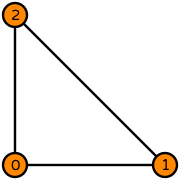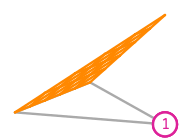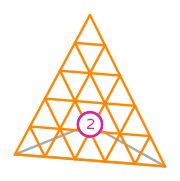an encyclopedia of finite element definitions
Degree 1 Kong–Mulder–Veldhuizen on a triangle
◀ Back to Kong–Mulder–Veldhuizen definition page
- \(R\) is the reference triangle. The following numbering of the subentities of the reference cell is used:
- \(\mathcal{V}\) is spanned by: \(1\), \(x\), \(y\)
- \(\mathcal{L}=\{l_0,...,l_{2}\}\)
- Functionals and basis functions:

\(\displaystyle l_{0}:v\mapsto \frac{1}{6} v(0,0)\)
\(\displaystyle \phi_{0} = - 6 x - 6 y + 6\)
This DOF is associated with vertex 0 of the reference cell.
\(\displaystyle \phi_{0} = - 6 x - 6 y + 6\)
This DOF is associated with vertex 0 of the reference cell.
\(\displaystyle l_{1}:v\mapsto \frac{1}{6} v(1,0)\)
\(\displaystyle \phi_{1} = 6 x\)
This DOF is associated with vertex 1 of the reference cell.
\(\displaystyle \phi_{1} = 6 x\)
This DOF is associated with vertex 1 of the reference cell.


